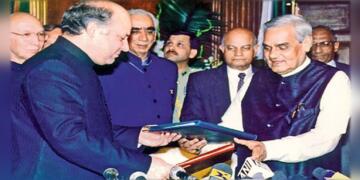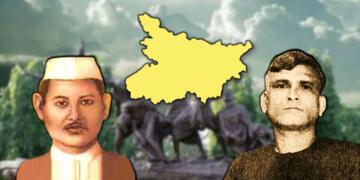“What’s in the name?” William Shakespeare once asked. The Sikh community responded with parents/grandparents, trade, profession, passion, personal achievements, clan, country, village, and town among others. Traditionally, Sikh names have been representing the kind of traits their parents wanted to inculcate in them. But over the last few decades, this trend has changed a lot.
Hinduism and Sikhism
Sikhism as the name suggests is rooted in Sanatan. In fact, the etymology of the word Sikhism, tells us that it has originated from Sanskrit, a language on which Sanatanis have their absolute claim. The word ‘Sikh’ literally means ‘student’ or ‘disciple’. A disciple entails the existence of a Guru. The word ‘Guru’ is again a Sanskrit word which means teacher.
Even the names of Gurus of Sikhs have similar origins. The word ‘Angad’ of Guru Angad Dev Ji, is the name of Angad who fought for Shri Ram against Ravan. Similarly, Arjan, the name of Guru Arjan Dev Ji, is a derivative of Arjun, the warrior prince of Mahabharat. There are a whole lot of other Sikh names that have a similar origin. Guided by 10 human Gurus and later philosophy engrained in Guru Granth Sahib Ji, Sikhs fought alongside Hindus in dethroning foreign forces of our motherland.
Hindus and Sikhs were not distinct
Traditionally, Sikhs and Hindus have been competing on healthy terms to keep Bharat Mata safe. Up until the 1870s, the collaboration between both communities was so strong that differentiating both communities was next to impossible. They had their differences about the way of life and the ultimate guiding force, but on broader issues like national interest, they were on the same page.
In fact, Indologist T N Madan has noted that not only they used to stay together but also shared common symbols and orientations. For a major section of the 19th century, considering Sikhism an offshoot of Hinduism was common. A lot of Sikhs, some of whom were direct descendants of Sikh Gurus used to address themselves as Sanatan Sikhs. They considered Guru Nanak Dev Ji as an avatar of Bhagwan Vishnu and Sikhism was believed to be a tradition aligned with Vaishnavism.
Sanatan origins of Sikh names
Even if we do not want to delve deeper into the technical evidence, the names of Sikh children recorded in the annual census are good enough to proclaim that Hindus and Sikhs, traditionally, did not like to be seen as separate factions. Most of the names given to Sikhs before our political independence have Sanatan origins. Even the names of Sikh freedom fighters will prove this point since almost all of them were from average Indian families.
Bhagat Singh, Udham Singh, and Sohan Singh Bhakna among others are some of the famous Sikh names who have sacrificed their lives for the country. Just by looking at their initial names, it is impossible to tell the religious column under which they were registered in the Census register.
Trend has changed
Even names such as Ram, Kishan (sometimes changed to Kishen), Gopal, Arjun, Dharmendra (Dharam+Indra), and Mohinder (Mohan+Indra) were also common. A large credit for India’s 1983 World Cup is attributed to a man named Mohinder Amarnath. Bishan Singh Bedi is another Indian hero who is Sikh but his name has Sanatan origin.
The problem is that most of these names are old and are no longer trendy; therefore, modern Sikhs do not prefer them. Few parents give their children names which have origins in Hindu Shastras. The transformation did not take place out of thin air. Apparently, there is a large and systematic nationwide movement behind it. Its culmination took a long time to show results, but it did.
Singh Sabha movement
The changing trend of Sikh names has its origin in the Singh Sabha Movement of the 1870s. By that time, Conversion Mafias had expanded their reach throughout India. Probably, the faction of Sikhs which delineated themselves from Hinduism thought that they were being targeted because there is very little visible difference between both. The movement, when it kicked off, soon snowballed into eliminating all existing evolutionary origins of Sikhism. Any Hindu connection was therefore seen to be adverse to the spread of Sikhism.
At this point, it is important to remark that they did not consider Hindus as their enemies. They only wanted to form a distinct identity of their own. It is understandable since at that time Sikh Empire had dissolved and the British had captured it, and the Khalsa was at the cusp of losing its relevance. Additionally, Arya Samaj founder Maharshi Dayanand’s views on Sikhism also did not go down well with Sikhs. For the purpose of propagating the true Sikh religion and restoring Sikhism to its pristine glory, they also planned to take influential British officials on board.
Expansion of Singh Sabha movement
The credit for initiation of this movement in Amritsar is attributed to Sir Khem Singh Bedi, Thakur Singh Sandhawalia, Kanwar Bikram Singh of Kapurthala, and Giani Gian Singh. Sandhawalia was elected as President and Giani Gian was chosen as Secretary. Soon, more and more people joined the movement, most of them as volunteers. These volunteers used to distribute historical and religious texts of Sikhism. To bring more efficiency, the vice-president, an assistant secretary, a giani (Sikh scripture scholar), an updeshak (preacher), a treasurer, and a librarian were soon recruited into the ranks.
It did not take long for the movement to expand in Lahore and over 100 other locations. Within two decades, Khalsa Diwans also came into existence, and recorded history indicates that in 1902, 150 Singh Sahibs and Khalsa Diwans emerged onto the scene. What did they do with this in-depth permeance into the polity? Well, they propagated the teachings of Sikh Gurus. Any practice contradicting their teachings was rejected and that is how purity doctrine made its way into Sikhism.
Tradition of naming their kids according to SGGS
Allegiance with Gurus became a key reason why most Sikhs started to adhere to naming kids from the Shri Guru Granth Sahib. The guidelines for naming kids are published in the ‘Sikh Rehat Maryada‘ document, which is published by the Shiromani Gurdwara Parbandhak Committee (SGPC) Amritsar. It has the authority of Shri Akal Takhat. The document tells Sikhs that when a new kid is born in their family, they need to seek the blessings of the Baani of Shri Guru Granth Sahib (SGGS) Ji.
To obtain this blessing, the first letter or word of a random page of SGGS is chosen. Then they proceed towards naming their children. So, for instance, if they pick a word starting with the letter ‘B’, the kid will be given names such as Balbir, Bahadar etc. In case they choose the whole word, that word is used as a prefix and an apt suffix is then searched for in order to give full name to the child.
That is how words such as Meet, Preet, Beer, Leen, Veer, Deep, and Jeet started to dominate the chart of Sikh names. However, these names also indicate how the movement to differentiate between Hinduism and Sikhism has become successful. The unintended aim of the Singh Sabha Movement was to eliminate every ounce of Hindu legacy before Guru Nanak Dev Ji taught a “new way of life” to people. The movement only wanted to adhere to his teachings.
Systematic change began in early 1900s
Initially, they were not successful; it took time for them to gain momentum. That is why by the early 1910s, the delineation agenda had not kicked off. The ultimate momentum started to fully grip Sikh society only after achieving two major legal victories. The 1909 Anand Marriage Act gave statutory recognition to a marriage rite of the Sikhs called ‘Anand’.
Later, Sikhs and the Sikh Gurdwaras Act, 1925 established direct Khalsa control of the major historical gurdwaras. Earlier, they were run by British-supported mahants and pujaris, later this act became a part of Gurdwara Reform Movement, which kicked off after “the Butcher of Amritsar” General Dyer’s genocide in Amritsar.
Also Read: While some Sikhs in India dream about another nation, Sikhs from other nations tell a different tale
Situation seems to be beyond repair
With Sikh Gurdwaras Act 1925, the mission to eliminate Sanatan influence from the daily lives of Sikhs was in action. To ensure that future generations do not get connected to Sanatan, tinkering with words started, the plinth of which was changing the names. The first generation was slow to adhere to it and those are the ones you would find with simple names.
But, the generation which took its first breath in independent India was faster to adapt to these waves. Rest of the work was done by Bollywood and the new kind of names (without any substantive basis) it promoted. The situation has now got so much out of hand that Hindu names have completely disappeared from the lexicon.
Support TFI:
Support us to strengthen the ‘Right’ ideology of cultural nationalism by purchasing the best quality garments from TFI-STORE.COM.
































